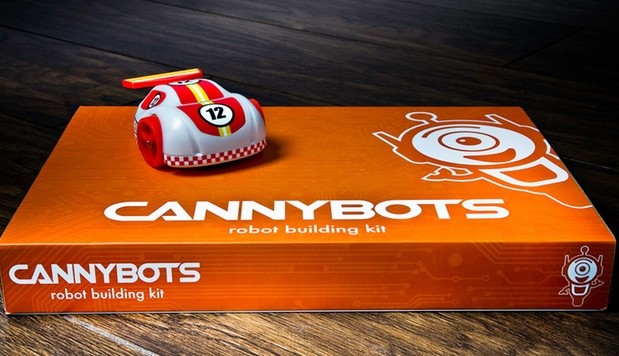Cannybots funded
October 07, 2015
on
on

The idea behind Cannybots came from a parent contemplating ‘de-addiction’ therapy for his 8 year old son’s overexposure to tablet PCs. Nine out of ten kids in the developed world have access to a smart device and can spend up to four hours a day on it. Trying to find the reason for this he realized that today’s toys are just not engaging enough compared to the digital media available via tablets.
The Cannybot is a fun way to introduce kids to programming, design, technology, 3D printing and STEM. In a domestic or school setting, kids can 3D print their own robots and use them to learn advanced programming techniques.
The system uses a syntax-free programming interface called CannyTalk, so that kids can learn the Logic (words) before they have to learn the Syntax (grammar) - just like they learn any other language. CannyTalk has been developed in collaboration with researchers at the Computer Science Department, University of Cambridge (UK). It is based on a Natural Language Processing (NLP) engine that can interpret the words typed in English and convert them to a form that Cannybot can understand.
Cannybot is fully open-source and the 44 x 33 mm main board contains:
• RGB Colour Sensor
• RGB Colour LED
• 3x on-board LEDs
• 2x IR sensors
• 18 GPIOs (14 on shield header)
• Analog (x5), digital (x14), i2c (2 banks), SPI, Serial, 4x PWM
• 75 kB Program flash, 2 kB RAM
• Based on ARM cortex M0 core (32 bit, 16 MHz)
• Operating voltage range: 1.5V to 7.5V
• Optional dual motor driver: 7.5V, 1.5A
• Reverse polarity protection
• Onboard battery monitoring
• Onboard battery charging with thermal protection
• CPU Debug Interface (SWD) broken out for custom programming and debugging (max: 256 kB Flash, 8 kB RAM)
The board is compatible with both the Arduino IDE and ARM mbed platform and can be programmed over the air from the Arduino IDE. For more information check out their Kickstarter page. With over thirty days to go, the project has already raised over three times its target.
The Cannybot is a fun way to introduce kids to programming, design, technology, 3D printing and STEM. In a domestic or school setting, kids can 3D print their own robots and use them to learn advanced programming techniques.
The system uses a syntax-free programming interface called CannyTalk, so that kids can learn the Logic (words) before they have to learn the Syntax (grammar) - just like they learn any other language. CannyTalk has been developed in collaboration with researchers at the Computer Science Department, University of Cambridge (UK). It is based on a Natural Language Processing (NLP) engine that can interpret the words typed in English and convert them to a form that Cannybot can understand.
Cannybot is fully open-source and the 44 x 33 mm main board contains:
• RGB Colour Sensor
• RGB Colour LED
• 3x on-board LEDs
• 2x IR sensors
• 18 GPIOs (14 on shield header)
• Analog (x5), digital (x14), i2c (2 banks), SPI, Serial, 4x PWM
• 75 kB Program flash, 2 kB RAM
• Based on ARM cortex M0 core (32 bit, 16 MHz)
• Operating voltage range: 1.5V to 7.5V
• Optional dual motor driver: 7.5V, 1.5A
• Reverse polarity protection
• Onboard battery monitoring
• Onboard battery charging with thermal protection
• CPU Debug Interface (SWD) broken out for custom programming and debugging (max: 256 kB Flash, 8 kB RAM)
The board is compatible with both the Arduino IDE and ARM mbed platform and can be programmed over the air from the Arduino IDE. For more information check out their Kickstarter page. With over thirty days to go, the project has already raised over three times its target.
Read full article
Hide full article


Discussion (0 comments)